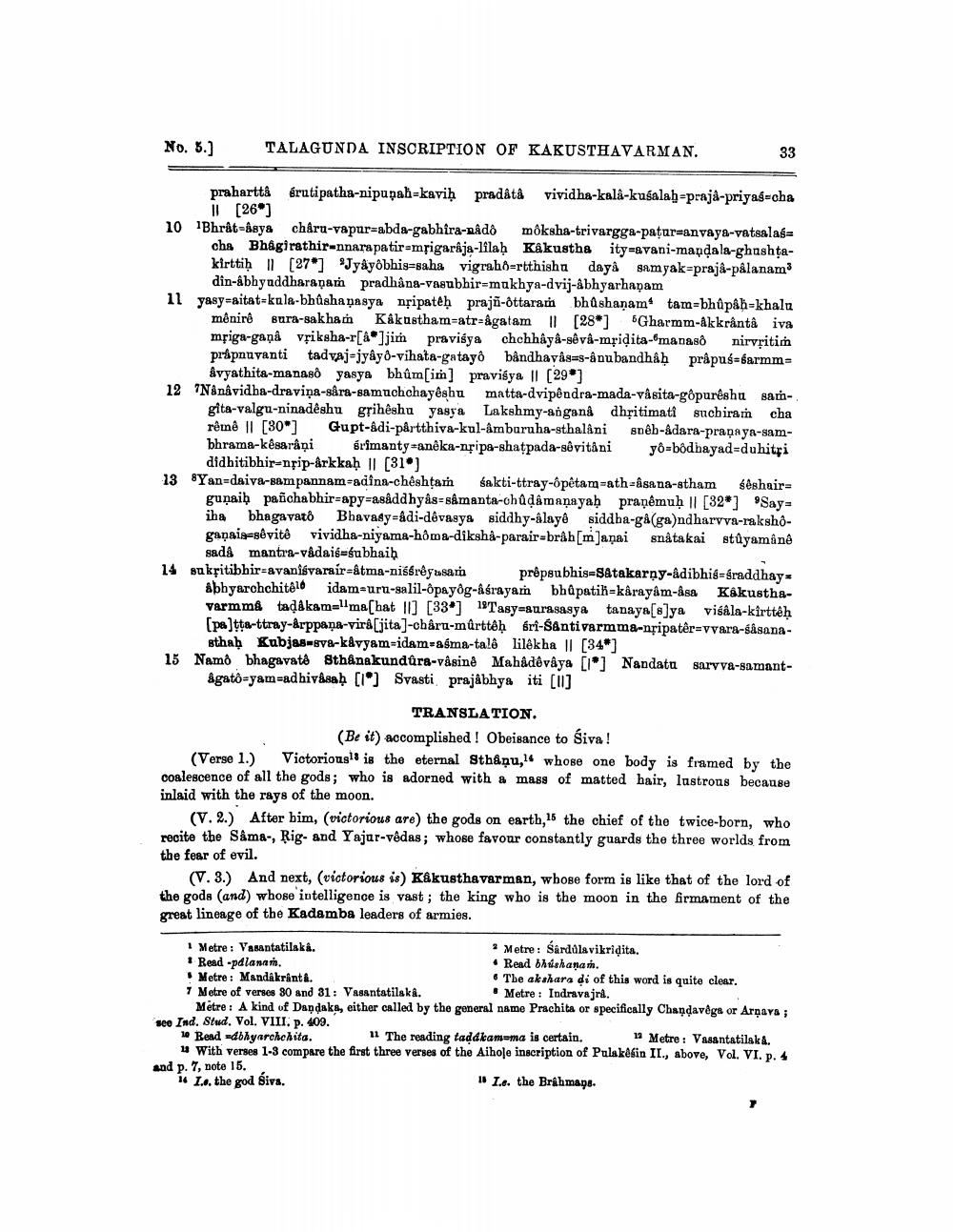________________
No. 5.)
TALAGUNDA INSCRIPTION OF KAKUSTHAVARMAN.
33
praharttå frutipatha-nipupah-kaviḥ pradâtá vividha-kala-kušalab=praja-priyagacha
| [26] 10 Bhrat-âsya chåru-vapur-abda-gabhira-nâdê moksha-trivargga-patar=anvaya-vatsalas=
cha Bhagirathirunnara patir-msigaraja-lilaḥ Kâkustha ity=&vani-mandala-ghashtakirttiḥ 11 [27"] 'Jyâyôbhis-saha vigrahô=rtthisha daya samyak-praja-pålanams
din-abhyuddharapan pradhân-vasubhiramukhya-dvij-Abhyarhnpam 11 yasy-aitat-kula-bhusha pasya npipateḥ prajñ-óttaram bhůshanam* tam=bhûpåh-khalu
mênirê sura-sakham Kakustham-atr=&gatam 1 [28*] Gharmm-akkrântâ iva mpiga-ganå vriksha-r[a]jim praviśya chchhayâ-sêvê-mpidita-manasð nirvritim prápnuvanti tadvaj-jyâyð-vihata-gatayê båndhayâs=s-ânubandhåḥ prapus=śarmm
âvyathita-manasd yasya bhům[im] pravisya || [29] 12 Nânâvidba-draviņa-såra-samuchchayeshu matta-dvipêndra-mada-våsita-gopurêshu san
gita-valgu-ninadêshu grihêshu yagya Lakshmy-angana dhřitimati suchiram cha rêmê || [30] Gupt-di-pártthiva-kul-ambaruha-sthalani snêb-&dara-praņaya-sambhrama-kesarâņi s rimanty-aneka-npipa-shatpada-sêvitâni yo=bôdbayad=duhitfi
didhitibhir-npip-arkkaḥ 11 (31°) 13 Yan-daiva-lampannam-adîna-chêshtaṁ Śakti-ttray-ôpetam-ath=âsana-stham séshair
gunaiḥ pañchabhir-apy=asådd hyås=s&manta-ohQdâmaņayaḥ praņēmuh || [32*] "Say= iha bhagavató Bhavady=&di-dévasya siddhy-alayê siddha-gA(ga)ndharvva-rakshoganaia-sêvitê vividha-niyama-hôma-diksha-parair=bråh[m]aņai snátakai stùyamine
sads mantra-vådaiś=śubhaib 14 sukritibhir=&vanisvaraír=âtma-niśérêgusamn p rêpsubhis-S&takarny-ådibhis=sraddhay
abbyarchchitél idam=urn-salil-payôg-åśrayam bhupatih-karayam-asa Kakusthavarmma tadakamama(hat II] [33"] 12Tasy-aurasasya tanaya[8]ya visala-kirtteh (pa]tta-ttray-&rppana-vira (jita]-chåru-mûrttêh fri-Santivarmma-nfipatêr=vvara-såsana
sthah Kubjas-sya-kávyam-idam-asma-tal8 lilekha || [34] 15 Namo bhagavató Sthånakundùra-vâsine Mahadevaya [lo] Nandata saryva-samant
ågatô=yam=ad bivsaḥ [*] Svasti prajâbhya iti [ll]
TRANSLATION.
(Be it) accomplished ! Obeisance to Siva! (Verse 1.) Victorious is the eternal Sthâņu, whose one body is framed by the coalescence of all the gods; who is adorned with a mass of matted hair, lastrous because inlaid with the rays of the moon.
(V. 2.) After bim, (victorious are) the gods on earth, the chief of the twice-born, who recite the Såma-, Rig- and Yajar-vêdas; whose favour constantly guards the three worlds from the fear of evil.
(V. 3.) And next, (victorious is) Kikusthavarman, whose form is like that of the lord of the gods (and) whose intelligence is vast; the king who is the moon in the firmament of the great linonge of the Kadamba leaders of armies.
1 Metre: Vasantatilaki.
9 Metre: Śårdúlavikridita. * Read -pdlanan.
• Read bhushanan. Metre: Mandåkrånt.
• The akahara di of this word is quite clear. 7 Metre of verses 80 and 31: Vasantatilska.
Metre : Indravajra. Metre: A kind of Daņdaks, either called by the general name Prachita or specifically Chandavégs or Arņavs; see Ind. Stud. Vol. VIII. p. 409. 10 Bead -dbhyarchchita.
11 The reading tadákamuma is certain. 13 Metre : Vasantatilska 4 With verses 1-3 compare the first three verses of the Aihole inscription of Pulakasin II., above, Vol. VI. p. 4 and p. 7, note 15. 14 L.. the god siva.
I L.e. the Brahmans.




